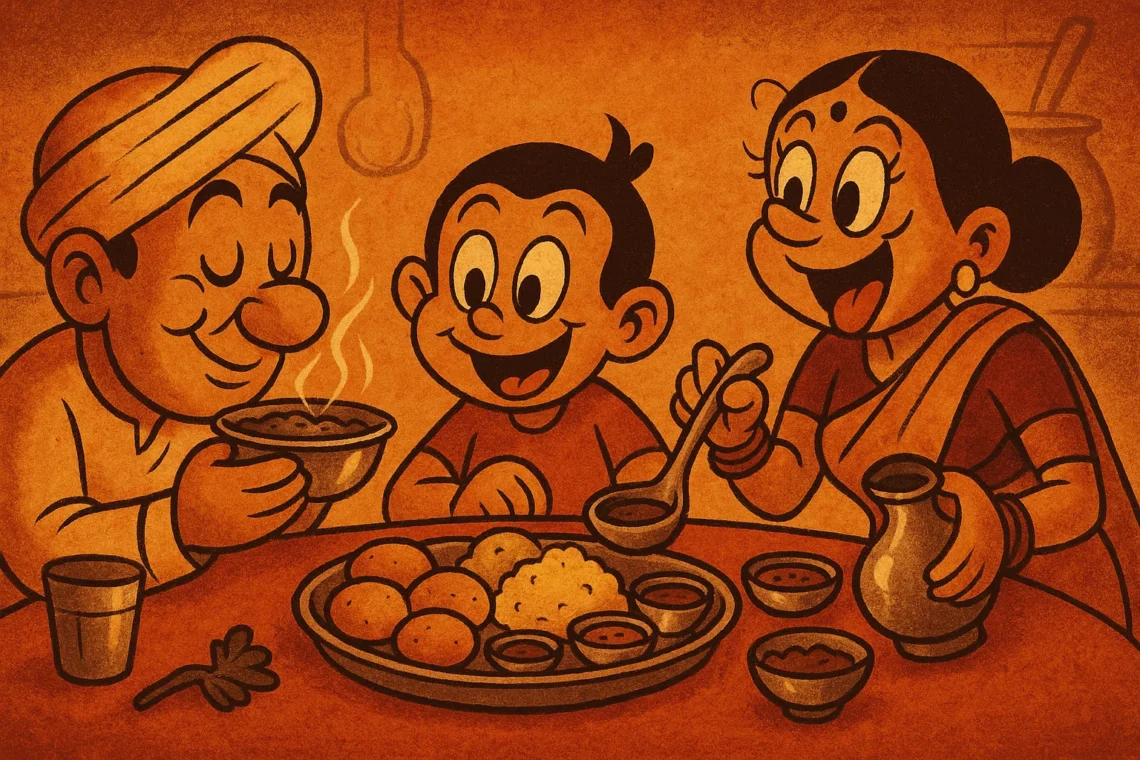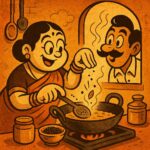Every meal in our home began with a sniff. Not a rude one. Not the scrunched-nose, skeptical kind. But a quiet, respectful inhale — a pause over the plate, eyes closed if the sabzi deserved it. Before the first bite, before the roti tore, before the rice was served, you’d lean in and smell the sabzi. Not because we were taught to. But because it was instinct. Because in Indian kitchens, fragrance is the first flavor.
My earliest food memories aren’t about taste. They’re about smell. The mustard seeds popping in oil. The warm, sharp scent of hing. The green waft of curry leaves landing in a pan. Even now, a good sabzi announces itself before it’s seen — through steam, through the air, through the way everyone drifts toward the kitchen without meaning to.
Sabzi as Storytelling
The smell of sabzi tells you everything before you taste it. You know if it’s going to be spicy, comforting, tangy, or confusing. You know who cooked it. Whether it’s a rushed weekday stir-fry or a slow, Sunday korma. You know if the cook was in a good mood — or trying to fix a bad one. One sniff and you can say, “Arrey, you added methi today?” or “Too much garlic, na?” or, my favorite, “Did Nani make this?”
At lunch, my father would often lift the lid from the serving bowl, take a long, silent sniff, and say nothing. That silence could mean satisfaction or suspicion — only the second bite revealed which. My mother, by contrast, would sniff mid-cooking, frown, and adjust something by intuition: a dash of amchur, a pinch of garam masala, a squeeze of lime. The sabzi, to her, was a dialogue. The smell was her cue.
It’s Not Just Aroma. It’s Anticipation.
In Indian cooking, you layer flavors by layering smells. You begin with oil — the smell of it heating, before anything touches it. Then jeera, which releases a nutty note. Then onions, which go from sharp to sweet in a slow unraveling. Then the dry spices, each one announcing itself in turn. By the time the vegetables go in, you’ve already built half the meal — not on taste, but on air.
Which is why, by the time the sabzi reaches the table, your appetite is already awake. One breath, and your stomach knows what’s coming. Even if you’re full, you’ll want a bite. Even if it’s karela, you’ll be curious. Because the smell doesn’t lie. It prepares you. It invites you. Sometimes, it even forgives a badly cooked dish with a great tadka.
The Ritual Lives On
Now, in my kitchen abroad, I catch myself doing the same. I lift the lid on my bhindi sabzi, lean over, and take that familiar breath. I don’t do it for anyone else. It’s not performative. It’s just habit. Memory. A way to check if it smells like home. If it smells like it’ll be okay.
When friends come over, they often comment on the smell — “Your place always smells like something good is happening.” And I nod, but I don’t explain. I don’t say that it’s the mustard seeds, or the turmeric, or the coriander that releases its perfume right when the flame is lowered. I just smile and offer a plate.
What Smelling the Sabzi Teaches You
To pause. To notice. To appreciate food before consuming it. To listen with your nose. Before your tongue claims the flavor, your breath gathers the story. Was this cooked with patience or panic? Is this for celebration or recovery? Is this reheated or just made? The smell always knows.
So yes, before you eat, you smell the sabzi. Not because it’s polite. But because it’s tradition. It’s instinct. It’s the first step in remembering that food isn’t just eaten. It’s absorbed — breath first, then bite.
Born in Mumbai, now stir-frying feelings in Texas. Writes about food, memory, and the messy magic in between — mostly to stay hungry, sometimes just to stay sane.












